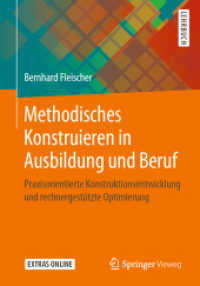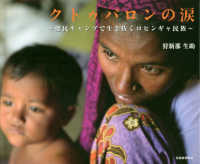- ホーム
- > 洋書
- > 英文書
- > Nature / Ecology
Full Description
Biological control (or Biocontrol) is the use of natural enemies (predators, parasitoids or pathogens) for the control of pests in crops. In classical biological control, a natural enemy is introduced as a new predator to a range where it is not native. In augmentative biological control, a large number of natural enemies are introduced, either in an area with no natural enemies like glasshouses, or to augment natural populations, to ensure a rapid pest suppression. In conservation biological control, habitats surrounding and within crops are managed to favour an increase in natural enemy populations while suppressing pest populations. These agroecological systems can be complex, and are affected by climate change, both negatively and positively. The object of this book is to synthesize and summarize current knowledge of the many ways climate change can influence the effectiveness of biological control systems. The book introduces the reader to general concepts and then describes climate change effects on the large diversity of macro- and microorganisms involved in biocontrol, and the possible increase or decrease in pest outbreaks following changes in characteristics (morphology, physiology, behaviour....), distribution or phenology. It then outlines methods for mitigating the effects of climate change through the adaptation of biological control strategies, including integrated pest management case studies from diverse continents and cultural contexts. Finally, it explores the economic and societal impacts of climate change on biological control systems. This is the second book in the CABI Ecostacking Series. Biological control is a major component of the ecostacking approach to cropping systems. It is intended for students, researchers, lecturers, and stakeholders engaged in biological control worldwide. It is also essential reading for research personnel and managers in companies that produce biological control agents for field application.
Contents
Section 1: Climate change and biocontrol of macro-organisms Chapter 1: Impact of climate change on macro-organisms used in biological control. Philippe Vernon, François Renoz & Thierry Hance Chapter 2: Change in diapause strategy in insects and impacts on pest populations. Kévin Tougeron & Jacques Brodeur Chapter 3: Biocontrol, climate change and population dynamics: Why is an increase of pest outbreaks and plant diseases transmitted by vectors expected following climate changes? Gang Ma & Chun-Sen Ma Chapter 4: Weed biocontrol with introduced insects under climate change. Yan Sun, SN Huang, Suzanne TE Lommen, Evan Siemann, Jianqing Ding & Heinz Müller-Schärer Chapter 5: Effects of climate change on plant defenses and its consequences for biocontrol. Paul Ode & Enakshi Ghosh Chapter 6: What do we know about the role of spiders in biological control under climate change? A bibliometric approach with insights on the Neotropical región. Luis Fernando García, Luis Quijano & Julien Pétillon Chapter 7: Bird-mediated effects of biological control under climate change: opportunities and challenges. Blas Lavandero, Pablo Díaz-Siefer, Natalia Olmos-Moya, Francisco E. Fontúrbel & Juan L. Celis-Diez Chapter 8: Impact of climate change on bats involved in biological control. Danilo Russo, Adrià López-Baucells, Carles Flaquer, Vanessa Mata, Orly Razgour, Carme Tuneu Corral, Xavier Puig-Montserrat & Hugo Rebelo Chapter 9: Community change and genetic differentiation in a small but contrasted area: insight from Trichogramma in south-eastern France. Ion Scotta Michela, Warot Sylvie, Vercken Elodie & Ris Nicolas Section 2: Impact of Climate change on plant pathogens and micro-organisms involved in biocontrol Chapter 10: Dynamics and evolution of fungal and oomycete plant pathogens and biological control agents under climate change. Ireneo B. Pangga, John Bethany M. Macasero & Romnick A. Latina Chapter 11: Impact of climate change on bacteria and viruses in Biocontrol. Clara Lago & Piotr Trebicki Chapter 12: Bacterial-insect symbiosis in a context of climate change: implications for parasitoidism and biological control. Thierry Hance, François Gilbert, Stefan Brandl, Maxence Jacquet & François Renoz Section 3: Adaptation of biocontrol to climate change Chapter 13: Challenges of aflatoxin biocontrol in maize under a scenario of climate change. María Silvina Alaniz-Zanon, Maria Laura Chiotta, Marianela Bossa, Paloma Rhein & Sofia N. Chulze Chapter 14: Adapting Integrated Pest Management to Climate Change. Joffrey Moiroux, Marie Perrin & Myriam Siegwart Chapter 15: Biological control and Integrated Pest Management in greenhouse crops and adaption to climate change. Carmelo Peter Bonsignore Chapter 16: Population growth of biocontrol agents and prey under climate change: A case study with acarine species. Matthew L. Meehan & Carlos Barreto Chapter 17: Controlling plant disease with plant growth promoting endophyte in the context of climate change. Lorena Barra-Bucarei, Javiera Ortiz-Campos & Hanna Cáceres Iparraguirre Chapter 18: Challenges and opportunities for conservation biological control of arthropods under climate change. Armando Alfaro-Tapia, Kevin Tougeron, Enrique Maldonado, Cécile Le Lann, Jacques Brodeur, Joan van Baaren & Blas Lavandero Chapter 19: Emerging insect invasions and climate change: Which biocontrol strategies for an effective prediction and early detection of invaders? Marie-Anne Rozenberg & Alain Roques Chapter 20: The influence of microclimates on the success of biological control. Sylvain Pincebourde Chapter 21: Advanced Crop Protection Strategies in Response to Climate Change: Integrating Technology and Innovation for Sustainable Agriculture. Darija Lemic, Ivana Pajac Živkovic, Sandra Skendžic & Helena Viric Gasparic Chapter 22: How could digital tools help IPM and biocontrol methods to mitigate the impacts of climate change? Yelitza Colmenarez, Carlos Vásquez, Steve Edgington & Bryony Taylor Chapter 23: Involvement of companies in Biocontrol in the context of climate change. Joan van Baaren Chapter 24: Looking for methods to value ecosystem services? An economic toolkit with a focus on biocontrol. Julie Ing & Marie-Hélène Hubert Chapter 25: Biocontrol seen from innovation management: a diversity of living technologies facing global change. Aura Parmentier-Cajaiba, Manuel Boutet & Thibaut Malausa








